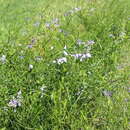Description
provided by Phytokeys (archived)
Woody vine to 5+ m long, scrambling in low vegetation, semi-aquatic and along water courses. Stems strongly ridged with 4 whitish green wings along the entire length, completely glabrous; new growth minutely papillose, occasionally pubescent with tangled simple uniseriate trichomes, these soon deciduous. Bark of older stems green to pale yellowish green, the bark not markedly exfoliating. Sympodial units plurifoliate, not geminate. Leaves simple, 2–6 cm long, 0.5–2 cm wide, lanceolate to linear (very occasionally with a few shallow lobes, but these lobed leaves always accompanied by simple ones on the same stem), somewhat fleshy to chartaceous, glabrous on both surfaces; primary veins 4–6 pairs, not prominent on either surface; base attenuate; margins entire, not markedly revolute; apex tapering to acute, the ultimate tip rounded; petiole 0.1–0.5 cm long, glabrous or occasionally with a few scattered simple trichomes adaxially, twining to aid climbing. Inflorescences terminal, becoming lateral and sometimes leaf-opposed, 4–13 cm long, usually 4–5 times branched, with 8–15 flowers, glabrous except for a few weak simple uniseriate trichomes at the tips of the branches; peduncle 0.5–2.5 cm long, occasionally absent and the branching beginning at the base of the inflorescence; pedicels 1–1.5 cm long, ca. 1 mm in diameter at the base and apex, slender, spreading at anthesis, glabrous, articulated at the base from a small sleeve and leaving a peg to 1.5 mm high on the inflorescence axis; pedicel scars widely spaced 3–10 mm apart. Buds ellipsoid, the corolla ca. 3/4 exserted from the calyx tube before anthesis. Flowers all perfect, 5-merous. Calyx tube 1.5–3 mm long, conical, the lobes 1–1.5 mm long, deltate to broadly semi-circular, glabrous, the tips papillate. Corolla 2.5–4 cm in diameter, violet, rotate-stellate, lobed ca. 1/2 of the way to the base, the lobes 8–10 mm long, 8–9 mm wide, planar to spreading at anthesis, abaxially densely pubescent with minute simple uniseriate trichomes ca. 0.2 mm long, adaxially glabrous with a few simple trichomes along the midvein. Filament tube minute, the free portion of the filaments ca. 1 mm long, densely pubescent with tangled weak simple uniseriate trichomes to ca. 0.5 mm adaxially so the ovary obscured; anthers 5–6 mm long, 1–1.5 mm wide, ellipsoid, loosely connivent, yellow, poricidal at the tips, the pores usually lengthening to slits with age. Ovary glabrous; style 11–15 mm long, sparsely pubescent in the lower 1/3 to 1/2; stigma clavate, the surface minutely papillate. Fruit a globose to ellipsoid berry, 1–1.2 cm in diameter, to 1.5 cm long, black and dull when mature (yellowish fide Cabrera 1983), glabrous, the pericarp thin; fruiting pedicels 1.2–1.5 cm long, ca. 1.5 mm in diameter, more or less woody, pendent from the weight of the berry. Seeds > 40 per berry, 1.5–2 mm long, 1–1.5 mm wide, rounded to flattened-reniform, pale yellow, the surfaces minutely pitted, the testal cells circular. Chromosome number: not known.
- bibliographic citation
- Knapp S (2013) A revision of the Dulcamaroid Clade of Solanum L. (Solanaceae) PhytoKeys 22: 1–432
- author
- Sandra Knapp
Distribution
provided by Phytokeys (archived)
(Figure 15). In the Río de la Plata drainage from Buenos Aires, Argentina and adjacent Uruguay to the upper Río Pilcomayo in Paraguay, and in coastal Brazil from Bahia south to Rio Grande do Sul, from 0-700 m elevation. Solanum amygdalifolium is also cultivated outside of its native range for its showy flowers (Bolivia, Andean Argentina).
- bibliographic citation
- Knapp S (2013) A revision of the Dulcamaroid Clade of Solanum L. (Solanaceae) PhytoKeys 22: 1–432
- author
- Sandra Knapp

